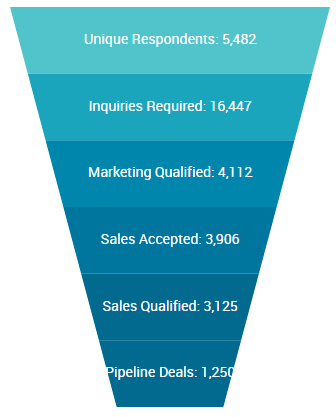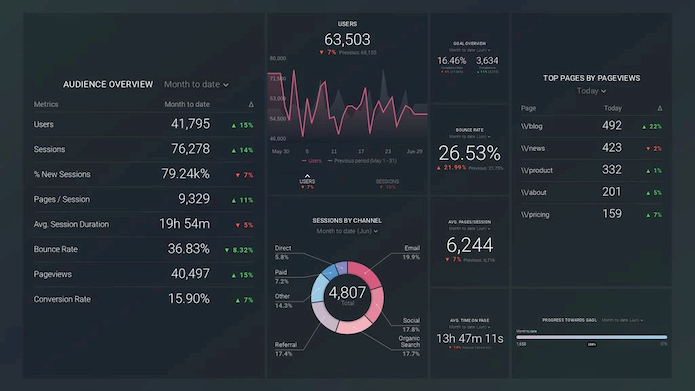
Written By:
Sean Henri
As a marketing manager, it’s important that you’re able to speak to the value of marketing for your organization. To do this, you need to calculate marketing’s contribution to business goals.
Here, you’ll learn:
-
How to communicate the value of marketing and calculate marketing’s contribution to the sales pipeline
-
The specific metrics you’ll want to track
-
How to do these calculations automatically with our free calculator
If you’re like many other marketing leaders, you’ve found yourself in an uncomfortable situation where you’ve just presented your latest updates to the rest of the senior leadership team, only to receive a reaction of confusion and blank stares.
“It’s great to hear about all the engagement on social… and the team sure has sent out a lot of emails, but how do we know if that’s good or not? How do we know it’s working?”
If you’re in this situation, you’ve failed to properly communicate marketing’s contribution towards business results. Even worse – you might not even know what marketing’s contribution actually is.
Marketing leaders who have fallen victim to this scenario can learn from their counterparts in sales. When joining a monthly or quarterly review, sales leaders will typically report on pipeline metrics that show progress towards pre-determined revenue goals and quotas. They speak the language everyone seems to understand and care about: the language of money.
So how can you turn things around and start communicating marketing’s true value? Let’s take a look.
Key Takeaways:
Report in revenue terms: Frame marketing results by their impact on pipeline and sales, not just traffic or engagement.
Base targets on four inputs: New-business revenue goal, marketing’s share, desired pipeline coverage, and average deal size.
Set funnel goals via conversion rates: Work backward from deals needed to define Inquiry → MQL → SAL → SQL targets.
Automate the math: Use Pepperland’s free Marketing Contribution Calculator and a Databox dashboard to calculate and monitor KPIs.
Link every tactic to business objectives: Align SMART marketing goals with revenue and growth to prove marketing’s value.
Communicating the Value of Marketing
To communicate marketing’s value to senior leadership, you need to be able to explain how your specific marketing efforts are contributing to larger business objectives. Sure, it’s great that you’ve increased website traffic and boosted social engagement, but what is this doing for the organization as a whole?
As a marketing leader, you need to track the metrics that are important to measure your success against marketing goals and the metrics that determine your progress toward larger business goals.
Use our Marketing Contribution Calculator
An easy-to-use, marketing contribution calculator that will automatically set your targets for you.
To calculate your pipeline metrics and determine marketing’s contribution to business goals, you first need to gather some inputs that you’ll use in your calculations.
Let’s run through some of the inputs that you’ll need.
1. New Business Revenue Required
It’s important to remember that not all revenue will come from new business. Typically your total annual bookings will come from a mix of existing accounts and new. Start by determining the percentage that needs to come from new, as this is where marketing will need to play a larger role.
2. Marketing Contribution Percentage
Unless you offer a SaaS solution, it’s rare that marketing will be 100% responsible for sourcing new business. Typically, the sales team is responsible for sourcing their own leads in addition to working leads that marketing generates. If you don’t know this number, start by reviewing your CRM data from the previous year. What percentage of leads were passed along from marketing to sales?
3. Sales Pipeline-to-Quota Ratio
Sometimes referred to as “pipeline coverage”, this metric indicates the desired amount of business in your opportunity pipeline relative to your quota for the period. According to SellingPower.com, most organizations prefer a ratio of 3X. The basic thinking behind this is that not all deals in your pipeline are going to close, so you want to have a certain percentage more than that (2x, 3x, 4x, etc.) in order to meet quota. If unsure, run with the 3x number.
4. Average Deal Size
Perhaps the most important of the four key inputs you need to capture is your average deal size. In other words, how many deals will you need to win in order to hit your revenue target? If unsure, once again you’ll want to turn to your CRM to get to this number. Simply run a report on the past 12 months of won opportunities, and determine the average value.
With these inputs and a few calculations, you can now calculate metrics like the Number of Deals, Pipeline Value, and Total Revenue that marketing should be responsible for in a given period. Consider these your primary marketing KPIs.

These KPIs communicate to upper management whether your marketing efforts have successfully contributed to the sales pipeline. To make this as easy as possible we’ve created a marketing contribution calculator that will do this math for you.
Once you’ve gathered these inputs and determined your KPI’s, you can take it a step further to break down the marketing funnel in greater detail.
To do this you’ll need to input your conversion rates for progression from each stage of the funnel to the next. This should include:
- # of unique inquiries per individual
- Inquiry-to-Marketing Qualified Lead (MQL) Conversion Rate
- MQL-to-Sales Accepted Lead (SAL) Conversion Rate
- SAL-to-Sales Qualified Lead (SQL) Conversion Rate
- SQL-to-Closed-Won Conversion Rate
By reverse-engineering your funnel backward from the number of deals required, you’ll be able to determine a target for each stage. Our Marketing Contribution Calculator Tool simplifies this process by doing the work for you; you’ll also get a PDF copy that you can share s with your team.
The tool also will provide you with your estimated Revenue per Inquiry, Revenue per MQL, and Revenue per Won Deal so that you can accurately say what each lead might be worth to the organization.
With your inbound marketing targets in hand, you can now begin tracking progress against these goals on a daily, weekly, and monthly basis. By doing so with consistency you’ll have a much easier time communicating why marketing has been doing what they’ve been doing, and how those activities are contributing towards business goals.
You can automatically track these metrics with a customizable dashboard using a tool like Databox.

Keeping Your Marketing Efforts in Line with Business Goals
To ensure that all of your marketing efforts are valuable for your organization and well-aligned with key business objectives, you’ll want to consider business goals from the very beginning.
When setting SMART marketing goals in the future, consider how each specific goal will contribute to a much larger business goal. What impact will an increase in website traffic have on Total Revenue? How will boosting engagement affect Pipeline Value?
With proper planning and goal-setting, you’ll be able to better communicate marketing’s contribution to business goals and speak to the value of your individual efforts.








